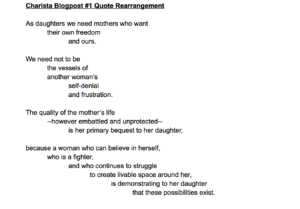Men have been able
to give
us
power, support
and certain forms of nurture
(as individuals)
When
they
choose
…
but the power
is always
stolen
power.
withheld from
the mass of women
in
patriarchy.
– Adrienne Rich, Of Woman Born (page 246)
This quote is one that stood out to me most in Adrienne Rich’s Of Women Borne. It was a favorite of mine because it seemed to capture so much in very few words. More specifically, this passage forced me to reconceptualize power and how I understand its creation and its use. Previously, I always understood power as something that allows people to create and enforce certain constructs. Adrienne Rich asserts power as a construct itself–– a fact I had never thought of. She even goes further to say that power is a patriarchal construct that is in many ways sustained by the ways in which it is distributed. Power does not belong to the patriarchy to give, and the patriarchy thrives off of taking power and redistributing it when it deems necessary.
Re-writing the passage as a poem forced me to even further reconceptualize a number of things. Firstly, words that initially struck me as some sort of philosophical theory felt more like natural thought processes in the form of the poem. Before I had written the poem, I wondered if the words would lose their weight, but they did not. If anything, I felt I was able to better understand Rich’s words in this form. They flowed, the words came individually rather than in the form of a wordy phrase as they once existed. In deciding exactly how to restructure the poem, I formatted as I read aloud. Thus, the structure of the poem felt comfortable to speak. Words like us and them that contrasted one another, to me, felt as though they should stand alone. I then had to make smaller decisions like using ellipses in place of a semi colon or even placing the words “as individuals” into parentheses, mostly to find a more natural way to account for the frequent use of commas in the original writing. It became interesting to me that poetry allows for frequent time to reflect within its structure, something that a traditional paragraph form does not allow for. This exerciser finally allowed me to understand Ntozake Shange’s emphasis on the importance of writing existing beyond the page. Whether as movement, speech or song, extending language beyond its written form only strengthens its ability to be understood.


